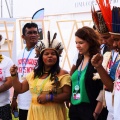As the climate talks wage on at COP20 in Peru, the country is grappling with the effects of a changing climate. Peru’s tropical glaciers have receded 40 per cent in the last four decades. The change strikes a blow to Andean watersheds and agricultural cycles.
It’s also affecting one of the most intimate aspects of Andean people’s lives: their faith.
Peru’s mountain range is home to 71 per cent of the worlds tropical glaciers. These imposing water towers guide the way of life for the people of the Andes: they store ice in the wet season, and in the dry season send meltwater down thousands of kilometres of streams to the region’s agricultural fields.
For the people of the Andes, however, the glaciers are more than the snow on their cliffs. The icy mountain tops of Peru take on spiritual significance. These high peaks are considered religious deities, or apus, within the Andean cosmovision.
The gathering of thousands of pilgrims in the glacier basin of Mount Ausangate for the festival of Señor de Qoyllurit’i marks one of the country’s most important religious celebrations. Pilgrims converge from every corner of the Cusco region in “pilgrim nations” for four days of continuous dancing, music and rituals.
The faithful honour in equal parts the sun, glacier, and Christian figures in an intricate synthesis of Andean identity. Each morning before the sun breaks, as the dancers kneel in prayerful anticipation for the rising of Tayta Inti, the Sun God, they reverently make the sign of the cross over their Incan or colonial-inspired dance clothes.
Central to the celebration is the glacier. Perhaps one of the most known figures in Andean folklore is the ukuku, the bear that guards the glacial apus. Pilgrims donning the outfit of ukukus protect the pilgrims throughout the festival, but in years past were also responsible for the ritual harvesting of large blocks of ice from the glacier, carrying the sacred waters home to their communities to fertilise and bless the soil for the harvest. The rapid disappearance of the glacier has prompted a ban against the ritual ice harvest.
Each year brings greater challenge to the apus in their promise to protect the harvest. Climate change is already felt in the highest regions of the Andes. Located close to the equator, tropical glaciers receive the sun’s strongest rays and are particularly sensitive to climate changes.
Farming communities now have a longer list of demands of the Taytacha. Nearly a thousand new glacial lakes have been registered in the last decade by the ministry of agriculture in Peru. Overflow from unstable glacial lakes cause frequent landslides, endangering homes, crops, land for agricultural use, and vegetable covering for grazing.
Rising temperatures make the list as well. Climate change brings lower yields for traditional high-mountain crops such as potatoes, and open the door to increase plagues and crop diseases. Conversely, harsh winds made the news cycle last year with a freeze killing hundreds of alpaca in the high plains of Peru.
Peru’s rivers, which supply much of the water for agricultural use and drinking, are fed by meltwater from the glaciers. The rapid melting of glaciers over time affects long-term water supply. Because much of Peru’s electricity is generated by hydropower, domestic energy supply and overall economic development will also be significantly affected.
Already under way are adaptation projects to protect some of the last pastoral and family farming communities of the Andes. Early warning systems to monitor glacial lakes can help to reduce the risk from outburst floods. Resilience in daily life comes in the shape of managing water use, reforestation projects to protect farmland, and adopting weather-resistant crops.
Even as mechanisms are implemented to protect physical landscapes the questions remain: what do we do about the preservation of religious and cultural practices? What about identity? In the words of Juan Carlos Riveros Salcedo, director of conservation at WWF Peru: “What happens when the ice disappears? What happens when the apu is devoid of her white cloak? What of all those manifestations based on the water coming off the glacier? We are talking about no more than thirty or forty years before they ice is gone complete.”
Faith, culture and identity are among the intangible costs of adaptation, often sidestepped by tangible costs such as food or health. Riveros Salcedo Riveros explains: “In utilitarian terms, we can say there will be less water, less power from the dams, maybe less agricultural production. But there is a cultural impact for the people for whom the snow makes sense. How can you explain to your grandchildren what they have never seen. The logic of how the ices speak to each other, the reflection of one glacier on the other, the shadows… even the shape of the hills will change.”
The case of Peru demonstrates that climate change affects more than the physical landscape as is often discussed. Says Riveros Salcedo Salcedo: “We talk a lot about the cost of adaptation. We say, well, it is going to cost usx million. When the reality is much more complex. The hypocrisy of these negotiations is that [they are] not putting on the table that we are literally negotiating with people’s lives.”
No single strategy can solve this aspect of climate change impacts. In the case of the Peruvian glaciers, their disappearance will also herald the loss of a major component of cultural heritage.












comment